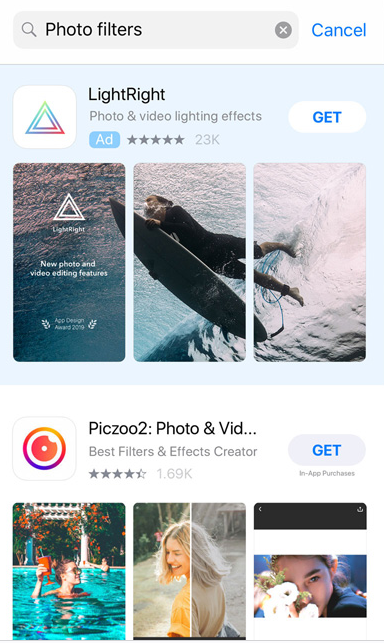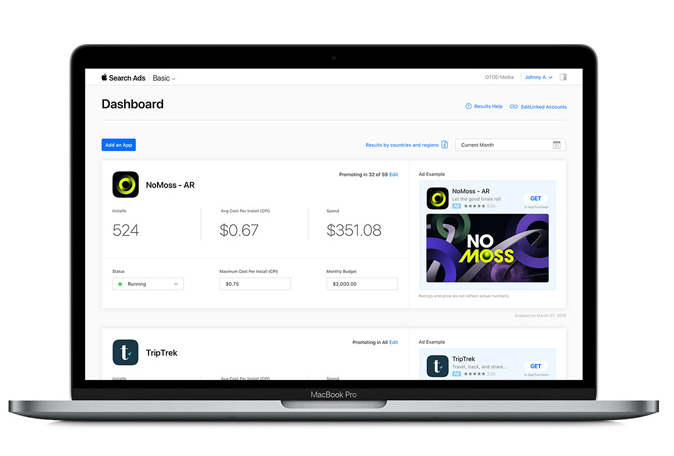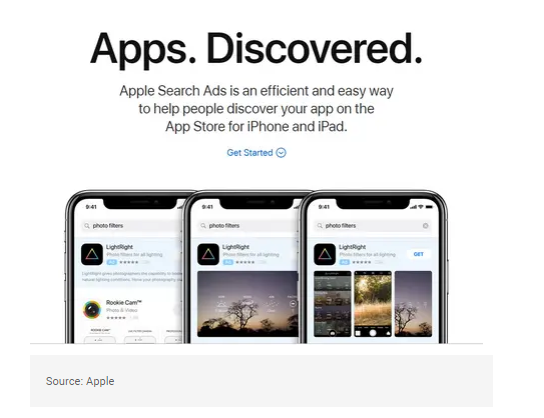Your Guide to Apple Store Search Ads
Apple Search Ads are also known as ASA or app store advertising, and they are “sponsored ads,” or the small advertisements that you see in the App Store. When you search for any particular app, these ads pop up to drive awareness and improve visibility of an app in the App Store. This is also categorised under “paid app marketing.” It is an effective way to get users to discover and use the apps that are most appealing to them at first glance.
These sponsored ads are only available in iOS devices like iPhones and iPads and are projected to generate up to $ 2 billion in revenue in 2020. Sponsored ads can be made more powerful using the strategy of bidding on relevant keywords to be able to successfully convert users.
Before getting started with the ads, you will need a valid email ID and Apple ID to sign up. Additionally, all advertisers must comply with Apple Advertising Policies.
What do these Apple Search Ads look like?
These ads appear in a light blue background with the ad icon in dark blue, the headline is black and description + rating appears in the light grey.

What is the availability of Apple Search Ads? Can I use this in my country?
Apple Search Ads were originally available only in the United States, but now Apple has made them available in 59 countries worldwide. You can get the whole list of countries here. Apple Search Ads have been made available in regions like Africa, the Middle East, Asia Pacific, Europe Northern America.
How do I start using Search Ads?
There are two solutions available to the advertiser: Apple Search Ads Basic and Apple Search Ads Advanced.
Apple Search Ads Basic:
With fewer features, this method is best for advertisers and developers who want to promote their app effectively without having to invest too much time in setup and management. Apple Search Ads Basic gets you quality downloads at a budget of up to $ 10,000/month per app and allows you to promote up to 50 apps. You don’t need to set any keywords. Instead, Apple will use an algorithm to match keywords according to potential customers. Apple will also take care of the audience filters, used to determine which users see which ads. The performance of the campaigns can be viewed in the performance dashboard.

Similar to Google Ads’ pay-per-click pricing model, Apple Search Ads Basic user pay only for every app installed at the max cost the developers are willing to pay (CPI).
Apple Search Ads Advanced:
If you want to have a more complex campaign, this method gives you the control of the audience targeting. Advertisers can take advantage of the following features:
- Select keywords
- Select a target audience
- Implement bidding strategies
- Schedule ads
- Target devices (iPhone, iPad, both)
- Upload creative assets
Unlike ‘Basic Search Ads’, there isn’t any budget limit per month and there isn’t any cap on how many apps you want to promote.
ASA works on the cost-per-click model (CPC) which means that you only pay when someone clicks on the Ad. Maximum CPCs bid limit can be set to keep control on overpaying for certain clicks. Using the available information on your app, Apple will then suggest a maximum CPC bid in order to help you boost or increase the likelihood of winning each auction. Apple also offers $ 100 free credit to developers trying its feature for the first time.

Ways to optimize Apple Search Ads:
User Type: If you would like to target a new audience or returning users, or target users who haven’t downloaded the app.
Keyword Relevancy and their match types: The more relevant your keyword is, the higher the chances of your ads appearing more often. You can perform your keyword search using SEMRush to identify which keyword is relevant for your ad as well.
Apple has 3 types of Match Types:
Search match: Apple’s machine learning system automatically searches for the most relevant keywords that are applicable to your ads.
Broad Match: Once you have used search match types, you would have a list of keywords that worked best for you and they can be used to populate the “broad match” type, which would be more effective.
Exact Match: To use this type, you would have to deactivate the “search match” types first and then define the keywords you want to target. You may also want to have misspellings deliberately as keywords so that you do not miss opportunities when the user types the keyword both correctly and with wrong spelling.
It’s best to have one ad group for each match type so you can maximize data collection and optimize from there.
- Location: You can target location segmented audience by campaigns. You can select the location here and try to target those specific countries.
- Basic and advanced: You can use both the types, however, the ads would be competing within themselves. This option might not fetch you good results if you are trying to promote the same app. If it’s the same app for auction, we would just be transferring the impressions from basic to advanced or vice-versa.
- Take advantage of negative keywords: You can block the traffic that is not relevant to your ad by adding them as negatives.
- A/B testing of creative assets: Apple allows setting up sets of custom arrangements of the screenshots of the app. Once the default creative is set, you can set up different creative sets to test out which ones perform the best.
- Optimize bids over time: It is essential for advertisers to adapt their strategy over time, changing bids and budgets to generate more installs and greater ROI. This includes monitoring whether it is worth raising the bid for a particular keyword or evaluating whether the budget is better spent on another keyword.

Monitor Search Campaigns:
Developers can monitor their ad groups, campaigns, and keywords in the Campaign Dashboard. It gives you a granular data choice like device, age, gender, LAT on installs/LAT off install and much more.
There are also ways that you can troubleshoot why your ads might not be running, payment issues, missing app details, low installs, etc. You can troubleshoot all the issues using this guide.
Apple claims that developers are achieving effective ROIs on their campaigns. Apple also claims that 65% of the downloads come from the App Store soon after a direct search.
Key Takeaway:
Apple Search Ads provides a new way to channelise and promote your apps. However, keep in mind to use the right method, relevant keywords, correct bidding strategy, and the appealing creative asset will take the campaigns to a whole new level and deliver a promising ROI. Try it out today!
Digital & Social Articles on Business 2 Community
(35)

